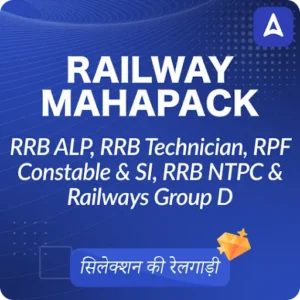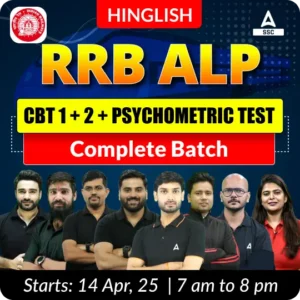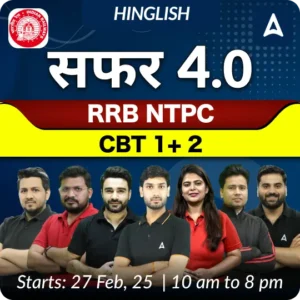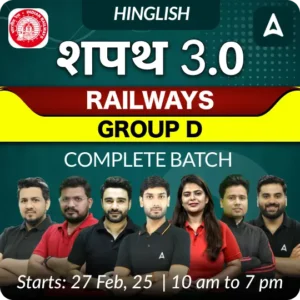Table of Contents
The Railway Recruitment Board (RRB) conducts the RRB ALP Psycho Test, also known as the Computer-Based Aptitude Test (CBAT), as the third stage of the selection process for Assistant Loco Pilot (ALP) after CBT 1 and CBT 2. This test evaluates a candidate’s mental ability, decision-making skills, and alertness—key qualities required for a Loco Pilot. Below are the complete details of the RRB ALP Psycho Test 2025, including its guidelines, exam structure, and question types.
Guidelines for RRB ALP Psycho Test 2025
To perform well in the RRB ALP Psycho Test, candidates must follow certain guidelines:
| Guideline | Details |
|---|---|
| Minimum Passing Marks | Candidates must score at least 42 marks to qualify for the CBAT. |
| Negative Marking | There is no negative marking for incorrect answers. |
| Test Focus | Tests assess memory, concentration, depth perception, and decision-making. |
| Preparation Advice | Carefully read all instructions and complete the tasks within the given time limit. |
Exam Structure of RRB ALP Psycho Test
The CBAT / Psycho Test consists of different test sets that check a candidate’s reflexes, concentration, and problem-solving skills. The CBAT consists of five test batteries, each designed to evaluate specific skills necessary for the RRB ALP role. The table below outlines the structure:
| Test Battery | Description | Skills Tested |
|---|---|---|
| Memory Test | Memorize and recall information such as maps or number-picture combinations. | Memory and recall accuracy. |
| Following Direction Test | Interpret and apply directions to patterns or sequences. | Direction-following ability. |
| Depth Perception Test | Analyze spatial relationships and identify depth-related features. | Spatial reasoning. |
| Concentration Test | Compare pairs of numbers or symbols for accuracy under time constraints. | Speed and accuracy in details. |
| Perceptual Speed Test | Identify and match objects rapidly to evaluate recognition speed. | Object recognition speed. |
RRB ALP Psycho Test Syllabus 2025
The RRB ALP CBAT Syllabus assesses key cognitive and psychometric abilities required for Assistant Loco Pilots. It includes five sections evaluating memory, concentration, spatial awareness, decision-making, and perceptual speed. The test is qualifying in nature, and scores do not affect the final merit list. Candidates should practice aptitude-based questions to perform well.
RRB ALP Psycho Test Exam Pattern
The RRB ALP Psycho Test 2025 is a crucial stage in the selection process for the Assistant Loco Pilot position. It tests the cognitive abilities, alertness, and decision-making skills of candidates. By understanding the exam structure, guidelines, and types of questions, candidates can prepare effectively and increase their chances of success. Here is the updated RRB ALP CBAT Exam Pattern Table with details about question numbers, marks, and other key elements.
| Test Battery | Description | Number of Questions | Marks per Question | Total Marks | Time Duration |
|---|---|---|---|---|---|
| Memory Test | Memorize and recall information like maps or picture-number combinations. | 20–25 | 1 | 20–25 | 5–10 minutes |
| Following Direction Test | Follow specific instructions and make logical adjustments to patterns or sequences. | 15–20 | 1 | 15–20 | 5–10 minutes |
| Depth Perception Test | Evaluate spatial judgment, such as analyzing a stack of bricks to identify spatial relationships. | 15–20 | 1 | 15–20 | 5–10 minutes |
| Concentration Test | Compare information quickly and accurately, such as checking for identical or differing pairs of numbers. | 20–25 | 1 | 20–25 | 5–10 minutes |
| Perceptual Speed Test | Assess the ability to identify and match objects quickly. | 20–25 | 1 | 20–25 | 5–10 minutes |
Key Features of Each Test Battery of CBAT
- Memory Test: Candidates are required to memorize specific information and recall it accurately under altered conditions. Example: Study a map with landmarks, then identify specific locations on a blank or modified version.
- Following Directions Test: This test examines the ability to follow complex instructions and make logical adjustments. Example: Given a sequence of letters, determine the result after applying directional shifts.
- Depth Perception Test: Depth perception evaluates the ability to interpret spatial relationships and identify depths or layers. Example: Count how many blocks in a stacked diagram are in contact with a specific block.
- Concentration Test: Focuses on candidates’ ability to compare details swiftly and accurately. Example: Identify if pairs of numbers are identical or different within a set time frame.
- Perceptual Speed Test: This test measures how quickly candidates can recognize patterns or discrepancies. Example: Match objects or symbols in a series, noting differences where applicable.
Questions asked in RRB ALP Psycho Test
To familiarize candidates with the format, here are some example questions:
| Test Battery | Sample Question |
|---|---|
| Memory Test | Memorize a number-picture combination for 30 seconds. Identify the correct picture for a given number. |
| Following Direction Test | A sequence of letters is given (e.g., ABCD). If you move the first letter to the end, what is the new sequence? |
| Depth Perception Test | In a diagram of stacked cubes, how many cubes are touching the base? |
| Concentration Test | Compare 10 pairs of numbers (e.g., 48219 vs. 48291) and indicate whether each pair matches or differs. |
| Perceptual Speed Test | Identify and match symbols like ☼, ♠, or ▲ within a grid of similar-looking characters. |
Tips for Success in RRB ALP Psycho Test 2025
- Understand the Test Structure: Familiarize yourself with each test battery’s format to save time during the exam.
- Practice Time Management: Use mock tests to hone your ability to complete tasks within tight deadlines.
- Stay Calm and Focused: Maintain composure to avoid mistakes under pressure.
By following these guidelines and practicing thoroughly, candidates can increase their chances of success in the RRB ALP Psycho Test 2025.




 How to Prepare for the RRB ALP CBAT Exam...
How to Prepare for the RRB ALP CBAT Exam...
 Konkan Railway Exam Date 2024-25 Out, Ha...
Konkan Railway Exam Date 2024-25 Out, Ha...
 RRB ALP CBT III Psycho Test Exam Pattern
RRB ALP CBT III Psycho Test Exam Pattern





 Adda247 Job portal has complete information about all Sarkari Jobs and Naukri Alerts, its latest recruitment notifications, from all state and national level jobs and their updates.
Adda247 Job portal has complete information about all Sarkari Jobs and Naukri Alerts, its latest recruitment notifications, from all state and national level jobs and their updates.